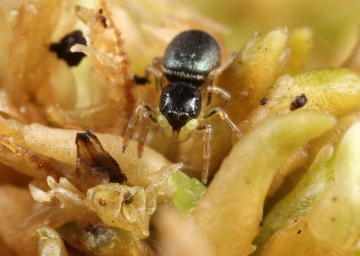Summary for Heliophanus dampfi (Araneae)
previous species | next species
National Distribution
Terms of Use. Double-click on map to go to region

Explore Regional Distribution
Please log on and add a note on this species
About this species
Recorded altitude range5m to 90m
Species text
DistributionRecorded from raised bogs in Wales and Scotland. The discovery of this spider in Britain was made in September 1989 at Cors Fochno, an estuarine raised bog in Cardiganshire (Williams 1991). Subsequently specimens of this species have been taken at Flanders Moss and Ochtertyre Moss in Perthshire, both raised bogs (Stewart 1993). In Europe it has been recorded from France, Belgium, Norway, Finland, Germany, Switzerland, the Czech Republic and Poland.
Habitat and ecology
Heliophanus dampfi is apparently found only on raised bogs throughout its range. On these the usual habitat in Europe is Molinia and Eriophorum (Bratton 1991). The Welsh specimens were pitfall trapped in low, dense Myrica, Erica tetralix and Eriophorum. On the Scottish sites pitfall trapping proved to be much less successful than sweeping and shaking out in obtaining specimens. Adult spiders appear to prefer the taller vegetation such as saplings of Scots pine and birch as well as clumps of Myrica and Vaccinium. Immature specimens were found at lower level in heather. Adult females are found from April to July, males in June and July.
Status
The spider seems well established at its known sites
Threats
Changes to the hydrological regime of bogs due to erosion or forestry are potential threats. With only three raised bog sites for this species it is vulnerable to the effects of human activities or stochastic events within a very short time period.
Management and conservation
Cors Fochno is a designated Special Area of Conservation (SAC), Flanders Moss is a NNR and Ochtertyre Moss is a SSSI.
Text based on Dawson, I.K., Harvey, P.R., Merrett, P. & Russell-Smith, A.R. (in prep.). References
Adult Season
Habitats
background methodology
Recorded management for locations with Heliophanus dampfi
Recorded substrate and hydrology for locations with Heliophanus dampfi
Images
please log on and upload a new image for this speciesSee also A-Z Species Index - A-Z Picture Index - previous species | next species

